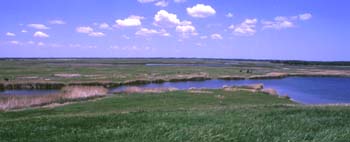
 |
| Goose Lake Prairie Nature Preserve |
"The dark sky seemed to crack open with a vivid, crooked dagger of lightning. William instinctively drew in his neck, knowing that when a storm was that close it meant the thunder-clap would follow hard on the flash. It came--whomp! The earth almost seemed to tremble from the crash."
- from William Kurelek's A Prairie Boy Summer"Day after day the sun beat down, baking our little house, shriveling up the plants, in the garden. It was so hot that nothing moved, not even the wind."
-from Jean Van Leeuwen's Going West
We call the prairie in Illinois tallgrass prairie, but Illinois prairies are not all the same. Prairies ecosystems in Illinois withstand a combination of hot summers, intense rainstorms, and severe winters. The differences in the types of prairies are the result of the land form and the type of soil and what happens to the water once it hits the ground.
Some prairies occur on hilltops, some on ridges, and some on low-lying land. The soils on these land forms are different and they will drain differently.
The draining of the soils at different rates causes some prairies to have little moisture in the soil, while other prairies remain wet for long periods of time. The terms dry, mesic, and wet are used to describe these different moisture levels.
Dry
The water in dry prairies is drained quickly, so little moisture is left in the fine-textured soil.
Mesic
Mesic prairies retain some water that slowly drains. The moisture and water content can be high for short periods of time.
Wet
In wet prairies, where the soil often contains clay, the water drains very slowly. Moisture and water content in the soil is very high over long periods of time.
These different levels of moisture content greatly affect the types of vegetation present in each area. For example, plants such as the sand milkweed are better adapted to dry conditions. Others, like prairie cordgrass, prefer wetter conditions. The compass plant, black-eyed Susan, and many others thrive in environments that are mesic.
|
|
Copyright © 2000 Illinois State Museum